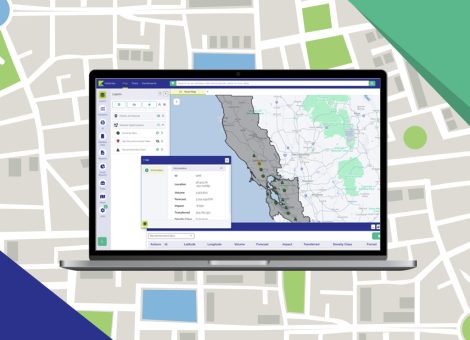Omnichannel analytics in today’s retail world
There is no “one size fits all” approach to analyzing omnichannel performance and potential for retailers. Solutions can be tailored to the desired use case or unique business questions that your team is trying to answer. What remains consistent across all omnichannel analyses is that these solutions can be very powerful when store trade areas and customer densities are accounted for, ensuring that a spatial element is incorporated in an assessment.
In this case study, our client asked us to quantify the impacts that brick-and-mortar real estate decisions have on e-commerce sales.
The client’s question
How can we better anticipate the effect that opening or closing a store will have on e-commerce sales when accounting for various market conditions (e.g., the presence/absence of existing stores, trade area coverage, market saturation, competitiveness, etc.)?
As apparel retailers continue their evolution, our client needed to quantify the correlation between online sales with the presence or absence of a store within individual markets throughout the US.
While all retailers face the challenge of understanding the relationship between physical stores and e-commerce spend, this particular retailer had the belief that they were overstored in several markets.
In addition to the application of traditional metrics used to evaluate closure candidates, was there an e-commerce impact worth considering to best identify the proper locations to shed?
Prior to working with Kalibrate, our client had two distinct internal teams (real estate) and online commerce) working and making decisions independently of one another.
Our approach
In conjunction with existing store location and sales performance data, we analyzed several years’ worth of historical e-commerce transaction data. Once all relevant first-party data from our client was assembled, we embarked on analysis that led our client down two distinct paths from a findings perspective – an Insights Path and an Actionable Path.
First, we analyzed online sales with a spatial perspective relative to the client’s existing store network — looking at the distance of e-commerce customers to stores, as well as whether they resided within or outside of defined store trade areas. This initial step was taken to better understand big-picture relationships and provide a perspective of just how important the presence of physical stores is to online sales. These observed relationships formed the foundation for our client’s journey down the insights path.
Next, our modeling team developed analyses designed to predict what would happen in the event of a new store opening or store closure. Initial business questions that were addressed included:
- Which customers do we anticipate will be impacted?
- How do the behaviors of impacted customers change before and after the real estate action?
- Do we anticipate increased, decreased, or neutral online sales with a real estate action?
Our team also conducted historical A/B testing using a series of store openings and store closures over a multi-year timeframe. Unimpacted customers acted as the control set against those proximate to a store opening or store closure, potentially triggering a change in shopping behavior or channel preference.
Testing scenarios
When we compared the two customer populations, we began asking additional questions like:
- Do customers spend more online when they have a store more proximate to them?
- Do e-commerce sales increase or decrease at a certain market saturation level (persons per store)?
- How much of an e-commerce sales lift do ‘first-in-market’ stores generate?
- Do physical stores cannibalize e-commerce customers?
- If we close a store, what % of sales will we retain via our e-commerce channel?
What were the results?
Traveling down the Insights Path, we learned that proximity to a store seemed to be much more impactful to one of the company’s two retail banners, an outcome believed to be related to brand awareness.
For both banners, e-commerce spend was higher among customers that reside within an existing brick-and-mortar store trade area. However, for our client’s more specialized banner, the difference was significant:
- While 63% of U.S. households did not fall within a store trade area, those which did spent over 250% more online with our client
- Customers that fell within two or more store trade areas (2.5%) spent over 400% more online
While we know that proximity to a store is a very strong driver of in-store sales, we were also able to confirm that proximity to a store is a significant driver of e-commerce sales performance.
Findings translate to action
As we move from Insights to Action, we were able to create “E-commerce Lift” and “E-commerce Recapture” tools for our client that were integrated within their location intelligence platform.
When their real estate team is evaluating the revenue forecast for a potential site, they can now assess the impacted households and apply either an e-commerce sales lift or cannibalization estimate to the forecast pending the site scenario.
Additionally, they can ensure that customers impacted by a potential store closure are adequately supported by the network and mitigate the risk of lost market share.
With the significant capital investment and challenging financial hurdles associated with physical locations, the “E-commerce Lift” tool appropriately credits potential sites for the incremental e-commerce sales they are likely to generate.
Innovations in omnichannel analytics
While there are many methods used to quantify the relationship between e-commerce sales and brick-and-mortar store performance, the incorporation of spatial analytics to address these concerns is surprisingly limited.
Our approach to solving omnichannel business questions is to evaluate e-commerce through a more traditional real estate analytics lens, with spatial analytics playing a crucial role in that process.
Our solution focuses on studying the relationship between saturation and distance using tried and true brick-and-mortar methodologies that value stores as an asset to the overall performance of the portfolio.
Read more about our omnichannel analysis
Read more articles about:
Location intelligenceSubscribe and get the latest updates
You may unsubscribe from our mailing list at any time. To understand how and why we process your data, please see our Privacy & Cookies Policy
Related posts
Location intelligence
Five burger companies, five problems
These burger brands had challenges from international growth to understanding franchise locations cannibalization,...

Location intelligence
Market Optimizer: Demo video
Market Optimizer allows users to strategically grow their network in existing markets while balancing revenue...


